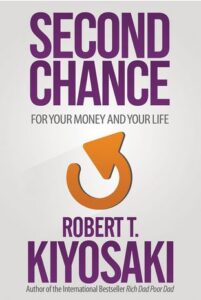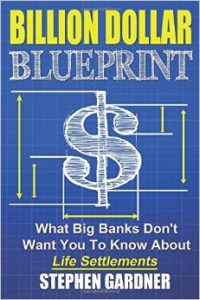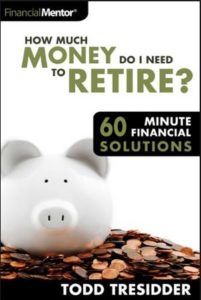
This book is a quick read, the type of book your read in a single sitting, but it packs a punch. It’s the type of book that attempts to re-align your thinking on a familiar topic. Most retirement books are about money and finances. This book is about living, with a sprinkle of finances thrown on top. All too often we can get lost in the weeds of our financial future without thinking about the things that matter most to us. Dickens’ portrayal of Scrooge has been a long favored reminder that money isn’t all that matters in life.
At Insurance & Estates we agree that money isn’t all that matters in life, far from it actually. Money is simply a tool that we control and use, rather than something that ends up controlling us. We also believe that there needs to be balance and planning, and Kelly agrees.
Kelly cautions that his view of retirement may look different than “the one you’ve imagined,” but hopefully his view gives you some food for thought.
Secret #1 – Don’t Retire
This “secret” sounds like a cop-out when it’s the first chapter of a retirement book. But Kelly is serious to some degree. Kelly points out that the whole economic purpose of retiring aging workers was to create jobs for the younger generation, (a very limited, socialistic idea). And it’s a relatively recent phenomenon.
“In 1880, when half of Americans worked on a farm, 78 percent of American men worked past age 65.”
But with the industrial age came new machines, that required workers to be newly trained. Those that had been experienced in the old way of doing things for 40 years no longer had the experience that was needed to work the new machines. So how do you encourage old workers to leave the work force when they are still capable of working? You provide a pension.
“In 1875, American Express offered America’s first employer-provided retirement plan.”
From this point in American history the popularity of private pension plans grew. Finally, it was in 1935 that the United States created Social Security, which is now an indispensable government plan for most Americans.
So, what is the point Kelly is trying to make? Kelly isn’t saying that you shouldn’t retire from the job that provides your paycheck. In fact he encourages it. He is saying that you should AVOID retiring to a life of leisure and games. Which is unfortunately a lie that many believe is the ultimate pursuit for retirees.
Kelly encourages you to retire to a life in pursuit of lifelong dreams. “The dreams we’ve selflessly set aside our entire lives so we could keep food on the table and our kinds in college.” Kelly believes that workers that have been in the work force for decades have a lot of talent, experience, and wisdom to offer to world. This talent is wasted on the golf course and on the couch.
What do you want to accomplish in retirement? What dream do you want to pursue? What have you neglected during your life that you will be able to strive for in retirement? What do you want to provide for your family, community, or even the next generation? These are the questions you should be considering as you approach retirement — in so doing, you may accomplish your biggest goals during your retirement years, like so many others before you.
Secret #3 – Fitness Matters
The third secret that Kelly mentions is that Fitness Matters. We all know that fitness promotes health and even cognitive prosperity, but Kelly focuses on the success stories of those that have done tremendous things in their retirement years.
One example is retired Navy surgeon, Paul E. Spangler, who at age 67 decided to take up running for the first time. Up until his death at age 95, Spangler amassed a huge list of records for running.
“Dr. Spangler claimed 85 national age group records at various distances. In his last competition…he won several gold medals at a senior Olympics meet in Palm Springs, Calif.”
Kelly also showcased Barbara Hillary, who at age 75 became the first black woman to reach the North Pole. And within a few more years she duplicated the effort by reaching the South Pole as well. Being on a fixed income, Hillary financed both trips by calling outdoor gear companies on a daily basis to sponsor her endeavor.
Kelly encourages those facing retirement to make fitness a goal. But he knows that fitness is not easy, and he identifies two key enemies. “The first of these enemies is Mr. Inertia. Mr. Inertia makes that first step so heavy and so ominous that it’s simply easier not to attempt.”
Kelly suggests fighting through that enemy by lacing up your shoes and taking any first step toward fitness. Just go for it and see how Mr. Inertia will loosen his grip on your life and mind. Even a little walk around the block can be a huge step in the right direction.
The second enemy is Mr. Discouragement. “He whispers things in our ear like, “Ha! You? Lose weight? Why didn’t you think about that 10 years ago? You’re far too fat to ever get back in shape.” And, unfortunately, we listen.”
When we listen to Mr. Discouragement we give up before the battle has even begun. We decide ahead of time that it’ll never work and we just keep doing what we’ve been doing (Mr. Inertia comes back to haunt us). Once again Kelly suggests that you begin with a first step, in so doing, you will give Mr. Discouragement and Mr. Inertia their first defeat. And these two enemies are never as formidable as they are at first.
Secret #4 – The Gratitude Revolution
The fourth “secret” that Kelly proposes is one that is likely to extend your life by doing “something you are guaranteed to be able to accomplish with ease.” The easy thing that Kelly is referencing is gratitude. In other words, he is encouraging us to make an effort to be grateful regularly in our life.
The scientific evidence that gratitude has health benefits is plentiful. Kelly shows numerous studies that show specifically what effects can be expected by following the encouragement to be grateful regularly.
“Thousands of years of literature talk about the benefits of cultivating gratefulness as a virtue” – Robert Emmons – UC Davis Psychology Professor
Kelly cites an article by Amit Amin titled, “The 31 Benefits of Gratitude You Didn’t Know About: How Gratitude Can Change Your Life,” in which the author collected the results of 40 different research studies on the topic. His first benefit suggests “A five-minute-a-day gratitude journal can increase your long-term well-being by more than 10 percent. That’s the same impact as doubling your income!”
Health Benefits of Gratitude
- More Time Spent Exercising
- Less Physical Pain
- Increased Sleep Duration and Quality
- Reduced Depression Symptoms
- Decreased Systolic Blood Pressure
- Less Time Required to Fall Asleep
- Increased Levels of Vitality and Energy
Kelly concludes his chapter on gratitude by stating that life is full of trials and challenges, and that we can’t successfully avoid them. Instead, we should attempt to meet these challenges with a thankful and gracious attitude, and we should practice this attitude daily.
Secret #7 – Financial Autopilot
The concluding chapter of Kelly’s book, Seven Secrets to a Happy Retirement, is the only chapter that really focuses on our finances. In this chapter Kelly suggests that in order for any retiree to enjoy the true benefits of the first six secrets, they must first be able to enjoy retirement without financial stress.
You won’t be able to pursue your dreams and aspirations if you’re barely meeting your expenses on a fixed income. You’ll find it difficult to focus on your fitness when you don’t have enough money to meet your needs if you get injured during exercise. And you’ll likely struggle to be grateful for your circumstances in life if you’re living on the bare minimum.
In defense of his position, Kelly references Abraham Maslow and his 1943 paper “A Theory of Human Motivation.” Maslow is famous for his theory of human needs. His theory suggests that humans will be unable (or unwilling) to seek after self-actualizing needs (like creativity and potential), if their fundamental physical and safety needs are not met. In other words, if we aren’t safe or we’re hungry, we won’t be brainstorming our next big adventure, we’ll be focused on getting our next meal.
Kelly provides a three part strategy for achieving financial autopilot in retirement. The first part of his strategy is to “remove the potential for loss from your portfolio.” You have worked hard to acquire a certain amount of savings as you enter retirement, and the odds of significantly increasing the amount saved is fairly slim. So the biggest threat to that pool of savings is the risk of a market downturn or some other financial detour that lowers your savings when you need it the most.
Part two of the Kelly strategy for financial autopilot is “don’t give up the opportunity for growth.” This part of the strategy addresses those that want to remove their money from the market and store in under their mattress or in a mason jar in the basement. Those are not good strategies for your retirement savings. You need to be able to outpace inflation.
Part three of the strategy is to “work with a professional who is fully informed on how to accomplish parts one and two of the strategy.”
Here at Insurance & Estates we heartily agree with Kelly on all three points. But it may seem like Kelly has hidden the real meat of his argument here. And to that critique, we agree as well.
Indexed Universal Life
Kelly is known as a retirement writer that promotes Indexed Universal Life (IUL) as the best retirement solution. In Seven Secrets to a Happy Retirement Kelly doesn’t discuss IUL. However, his strategy puts forth one of the key selling points of an IUL, namely that it has a rate floor built in to the product.
Normally this rate floor is around 0-1%. In addition, the growth that is part of the strategy is also part of the IUL policy selling points. Most IULs have a rate cap of around 13%.
With these two “bookends” in place your policy cash value (the account that you are relying on for retirement) has the ability to grow up to 13% per year, while also have a guaranteed minimum “floor” of around 1%.
Safety is a big selling point of the IUL, but it doesn’t matter if you can’t outpace inflation. That’s where the rate cap of 13% comes into play — you can have excellent years that significantly outpace inflation and help boost your account value in a single year. And with the rate floor, you know you’ll never have less than you had the year before (assuming you continue to pay your premiums and you aren’t pulling money out).
Conclusion
Kelly is excellent at presenting the problems and financial solutions in an enjoyable and readable fashion. You’ll likely enjoy his book if you choose to pick it up. You’ll also get a chance to read his other “secrets,” which are also valuable to the overall retirement discussion.
At I&E we value any discussion on the dilemma that faces people planning for retirement today. All over the country Americans are facing a looming retirement with underfunded retirement accounts and increasing medical bills. Anyone that can provide some solutions to the problem is a welcome voice. Kelly offers more solutions than problems, and for that we thank him, and we recommend his book.
If you’re looking for help figuring out your retirement road map, we’d love to offer a free consultation, so contact us today.





